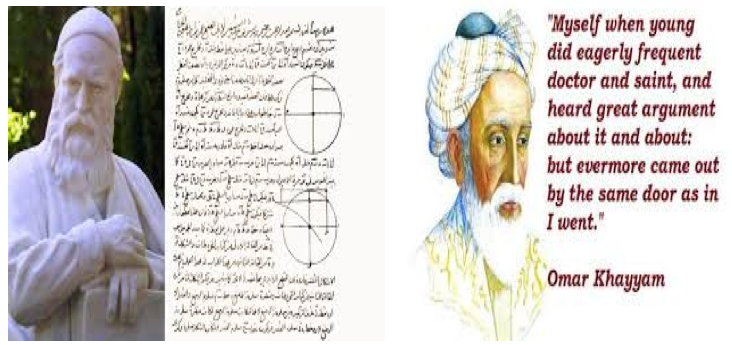[Originally published as part of my Column “Green Cardamoms “ in Shillong Times, Canvas, page 3].
OMAR KHAYYAM
Author: Gaurangi Maitra

photo credits: www.rta.org.af & www.readinglives.blogspot.com
Memory tags: A My father quoting from memory or reading from the brocade bound 1955 Folio Society edition of Rubaiyat of Omar Khayyam.
Amid the past and present, among memories and violence, between Persia of yesteryear and Iran of today stands the statue of Omar Khayyám. A connoisseur with consummate skill has gently folded back the cuffs of his long loose coat, allowed the shawl to drape one shoulder, furrowed the forehead in thought and let the hands hold the manuscripts, the skill rendering the opaque marble translucent with inspiration! Khayyam, the tent maker by family tradition who came instead to be a renowned mathematician, philosopher, astronomer and poet deserved no less! The fame of Omar of the Rubaiyat of Omar Khayyam, would travel ahead of Omar Khayyam the mathematician after it was rediscovered early in the19th century.
Early in the summer of 1857 Professor Edward Byles Cowell, browsing through the Asiatic Society Library in Calcutta came across a book of Persian quatrains. Having studied Persian from the age of fifteen he was easily able to read through the lines so famous in translation to us today.
“AWAKE! for Morning in the Bowl of Night
Has flung the Stone that puts the Stars to Flight:
And Lo! the Hunter of the East has caught
The Sultan's Turret in a Noose of Light.....”
Rubaiyat of Omar Khayyam, written in the11th century had fallen into the able hands of Cowell who had studied Hindustani, Bengali, and Sanskrit with Indian scholars and became principal of Sanskrit College in1858! He even sent a copy to his former student Edward FitzGerald who was interested in Literature and Classics. Strangely, both Cowell and FitzGerald published their initial translations anonymously! The volume, I hold in my hand now, is the first version of Edward FitzGerald. Bound in beautiful brocade, illustrated with luminous miniatures from a 911 manuscript and published by The Folio Society in1955. It is a present and the inscription says ‘… to read with delight….’ .And down memory lane travels a voice that would so frequently quote,
“Ah, Moon of my Delight who know'st no wane,
The Moon of Heav'n is rising once again:
How oft hereafter rising shall she look
Through this same Garden after me -- in vain!”
Time, is an oft recurring motive and with it change and impermanence. For our poet was so well acquainted with celestial ways that in 1073, Malik-Shah I,( 1072-92), invited Khayyám to build an observatory, along with other distinguished scientists. Here Omar made a calendar more accurate than the Gregorian calendar of 500 years later. Khayyám and his colleagues at the observatory had measured the length of the solar year as 365.24219858156 days! The modern Iranian calendar is based on his calculation. He would explain the fact that different constellations appear as the night progresses, through a simple, elegant experiment. Using a revolving platform and simple arrangement of the star charts lit by candles around the circular walls of the room, he demonstrated that earth rotates on its axis, bringing into view different constellations throughout the night! And so he would perhaps be moved to write,
“The stars are setting and the Caravan
Starts for the Dawn of Nothing- Oh, make haste!”
In the University of Teheran is kept an untitled two chaptered manuscript. The first page reads, "Cubic equation and intersection of conic sections". He would leave behind mathematical work especially in the fields of geometry and algebra. Theory of parallels, the first exact method of solving cubic equations, and a general binomial theorem is based on Omar Khayyam’s ability to extract roots, besides the Khayyam-Saccheri quadrilateral. His most widely referred mathematical book is "Explanations of the difficulties in the postulates in Euclid's Elements". And did this prompt him to write,
“For ‘IS’ and ‘IS-NOT’ though with Rule and Line,
And ‘UP-AND DOWN’ without, I could define….”
Hailing from the town of Nishapur, in Iran, then a Seljuk capital in Khorasan (present Northeast Iran), his home town rivaled Cairo or Baghdad. He spent part of his childhood in the town of Balkh (present northern Afghanistan), studying under the well-known scholars and teachers. And he would write,
“With them the Seed of Wisdom did I sow,
And with my own hand labour’d it to grow;
And this was all the harvest that I reap,
I came like Water, and like Wind I go.”
Omar Khayyam probably in the final analysis had the ability of mystics to make the mundane universal and so would leave us to ponder,
“And strange to tell, among that Earthen Lot
Some could articulate, while others not:
And suddenly one more impatient cried--
"Who is the Potter, pray, and who the Pot?"
Main resources:
- Rubaiyat of Omar Khayyam
- Wikipedia
- Encyclopedia Britannica
